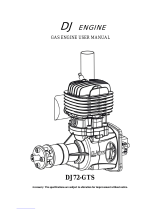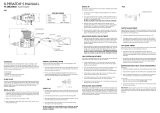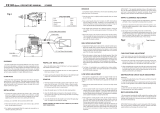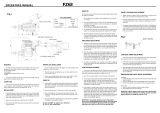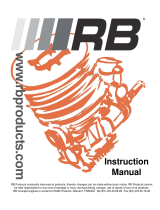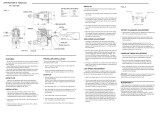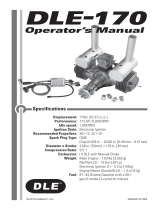Page is loading ...

Single Cylinder Ringed Four Cycle Engine
MAGNUM XL 1.20RFS
The Magnum XL 1.20RFS is a single cylinder, overhead valve four stroke
engine incorporating ringed piston technology for long life and a dual needle
carburetor for precise adjustments. A polished aluminum muffler is in-
cluded to keep the noise to a minimum without sacrificing power. The
engine was designed by expert engineers and built by master craftsmen
using only the highest quality materials and CNC machinery. These quali-
ties provide the long life and dependability you have come to expect from
an engine of this caliber.
INTRODUCTION
BECOMING FAMILIAR WITH THE MAGNUM
XL 1.20RFS
Before attempting to operate your new engine, please read through this
instruction sheet in it’s entirety. This will help you familiarize yourself
with the features and operation of your new engine. Use the photos below
to identify the major component parts of your new engine.
SPECIFICATIONS
Displacement.............................................19.6cc (1.22cu.in.)
Bore............................................................................30.4mm
Stroke..........................................................................27.5mm
Practical R.P.M.................................................2,000 - 11,000
Weight (w/Muffler)....................................................31.08oz.
Crankshaft Thread Size...............................................5/16-24
WARNING!
Magnum model engines will consistently give you dependable performance
and reliability and will be a source of satisfaction and pleasure if you fol-
low these instructions as to the engine’s proper and safe use. Do not let
pleasure turn into injury and/or tragedy! You alone are responsible for the
safe operation of your engine, so act sensibly and with care at all times.
This Magnum model engine is not a toy. It is a precision built machine
whose power is capable of causing serious injury to yourself and others if
abused, misused or if you fail to observe proper safety precautions while
using it.
N Keep spectators, especially small children, at least 20 feet away from
the engine while it is running.
N Mount the engine securely in the airplane or on a suitable engine test
stand to run the engine. Follow the mounting instructions in your kits
instruction manual or on the plans for individual mounting recommenda-
tions. Do not clamp the engine in a vise to test run it.
N Use the recommended size propeller and follow the proper procedure
for mounting the propeller. Use the correct size wrench to tighten the
propeller nuts. Do not use pliers.
N Inspect the spinner, propeller and propeller nuts on a regular basis,
looking for any signs of nicks, cracks or loosening.
N To stop the engine, adjust the throttle linkage to completely close the
throttle barrel and therefore cut off the air supply. You can also pinch the
fuel line to stop the engine, but only if it is accessible. Do not throw
anything into the spinning propeller or attempt to use your hands to stop
the engine.
N Stand behind the engine when it is running to make any adjustments
to the mixture controls. Do not reach over or around the propeller. Do not
lean towards the engine. Do not wear loose clothing or allow anything to
be drawn into the spinning propeller when the engine is running.
N If you need to carry your model while the engine is running, be con-
scious of the spinning propeller. Keep the airplane pointed away from you
and others.
N Do not use tight fitting cowls or oversized spinners as these can im-
pede airflow over the engine and result in overheating and damage to the
engine.
INSTALLATION
q Engine Orientation
The Magnum XL 1.20RFS can be orientated in any position on the fire-
wall. Keep in mind that when the engine is mounted inverted, carburetor
adjustments will need to made differently and the fuel tank may need to be
lowered. (See tank size and orientation to carburetor on next page).
Rocker
Cover
Cylinder
Head
Thrust
Washer
Prop
Nuts
Prop
Washer
Crankcase
Exhaust
Pipe
Pressure
Nipple
Muffler
Intake Pipe
Carburetor
Choke
Assembly
Detent Spring
High Speed
Needle Valve
Fuel Nipple
Idle Stop
Screw
Throttle
Arm
Low
Speed
Needle
Valve
Crankcase
Breather
Return
Tube

PROPELLER, FUEL & GLOW PLUG
q Propeller Recommendation
The diameter and pitch of the propeller needed for the XL 1.20RFS will
vary greatly depending on the application the engine is used in. The weight,
drag and the type of model and how you intend to fly it are all factors in
determining the correct size propeller to use. Experimentation will be nec-
essary to find the optimal size propeller for your particular application.
Ideally you want a propeller that the engine will turn in the 8,000 - 9,000
R.P.M. range, yet power the airplane sufficiently. Using a propeller that is
too small will cause the engine to run at too high an R.P.M. Using a pro-
peller that is too large will cause the engine run at too low an R.P.M. and
cause it to lug down too much. In both instances this can lead to premature
engine wear and eventual failure.
Propeller Size Recommendations
q Engine Bolts and Firewall Requirements
The engine should be mounted to a heavy duty glass filled nylon or a metal
engine mount. Use only high quality steel cap screws and related hard-
ware to mount the engine to the motor mount. The firewall in the airplane
should be aircraft grade 5-ply plywood and be no less than 1/4” thick. The
firewall should also be reinforced to meet the torque and weight of the XL
1.20RFS engine.
q Muffler and Exhaust Pipe Installation
The muffler threads onto an exhaust pipe, which then threads into the en-
gine head. First thread one cinch nut onto each end of the exhaust pipe.
Thread the muffler on one end. The
muffler should be threaded on at
least 1/4” to prevent vibration from
damaging the threads. Once you
have threaded the muffler onto the
exhaust pipe use an open end
wrench and tighten the cinch nut up
against the muffler. This will pre-
vent the muffler from loosening.
The exhaust pipe is adjustable to better match the scale appearance and
installation of your particular application. Thread the exhaust pipe into the
engine’s cylinder head. The pipe should be threaded in no less than 1/4”
to prevent vibration from damaging the threads. Once you have threaded
the exhaust pipe in place and into the proper position for your application,
use an open end wrench and tighten the cinch nut against the cylinder head.
This will prevent the exhaust pipe from loosening.
q Tank Size and Orientation to Carburetor
Ideally the stopper in the fuel tank should be even with the high speed
needle valve or just slightly below the high speed needle valve. Most
models will only allow the fuel tank to be mounted higher than the ideal
location. A fuel tank that is positioned higher than the ideal location usu-
ally doesn’t pose any problem except when it is mounted excessively higher
and/or used in conjunction with an inverted mounted engine or during ex-
treme aerobatic flight. If mounting your engine inverted it is advised to
lower the fuel tank so the stopper is slightly below the high speed needle
valve. Doing this will prevent fuel from siphoning into the engine and
flooding it when the fuel tank is full. If you cannot lower the fuel tank far
enough, we suggest lowering it as far as can be allowed in your particular
application.
The size of the fuel tank used should be 12oz. - 16oz. depending on
the model and the length of flights desired. Use of a 16oz. tank will pro-
vide between 15 - 20 minutes of run time at full throttle. Use of a fuel tank
any larger than 16oz. can lead to excessive leaning of the engine during
flight and is not recommended.
q Carburetor Orientation
In some cases the particular installation of the engine in your model may
make it necessary to change the position of the carburetor. You may want
the throttle arm on the opposite side
than how it comes preinstalled. You
can remove the carburetor and re-
install it in the opposite direction
with no effect on performance. To
remove the carburetor loosen the
two screws holding the intake mani-
fold in place. Next, remove the two
screws holding the choke assembly/
carburetor to the engine. Remove the carburetor by gently pulling it down
off the intake pipe. To reinstall the carburetor reverse the process. We
highly recommend applying machine oil to the o-ring inside
the carburetor mounting base and on the carburetor mounting flange on the
intake pipe. This will prevent the o-ring from being inadvertently cut when
reinstalling the carburetor.
q Needle Valve Extension
If an extension is required to adjust the high speed needle valve, use a
1.5mm diameter wire of the necessary length. Loosen the set screw in
the side of the needle valve, insert the wire into the end of the needle
valve and tighten the set screw firmly. If the extension is more than 3”
long we recommend supporting the outer end of the extension to prevent
excessive vibration.
q Propeller Installation
Your engine comes equipped with a main propeller nut and one safety nut.
For your safety, we recommend using both the propeller nut and the safety
nut to secure the propeller in place.
Note: Before installing any propeller it must be properly balanced.
Running an engine, especially of this size, using an improperly balanced
propeller can lead to excessive vibration causing excessive stress and wear
on both the engine and the airframe. Balance the propeller using the recom-
mended method of the propeller manufacturer. Several products are avail-
able to properly balance propellers. Ask your local retailer for more infor-
mation about these items.
Using a 5/16” drill bit or a prop reamer, drill out the hole in the propeller
hub to fit the crankshaft. The crankshaft is 5/16” in diameter. Slide the
propeller onto the crankshaft, up against the thrust washer. Slide the pro-
peller washer up against the propel-
ler. Thread the prop nut onto the
crankshaft. Notice that the prop nut
has a flange on the back of it. This
flange fits inside the washer. Com-
pletely tighten the prop nut to se-
cure the propeller in place. Install
the safety nut onto the crankshaft
then tighten it against the prop nut.
When tightening the prop nut and
safety nut, use the proper size open end wrench. Do not use pliers.
Note: If you are installing a spinner onto your engine the cone of the
spinner must not rub against the propeller. If the spinner cone rubs against
the propeller this could lead to propeller damage and eventual propeller
failure.
15 x 6 15 x 8 15 x 10
16 x 6 16 x 8
Use 15 x 6 for initial break-in procedures
Muffler
Exhaust Pipe
Cinch
Nuts
Loosen
Intake
Pipe
Remove
Thrust Washer
Prop Nut
Safety
Nut
Prop Washer

q Glow Plug Recommendation
Glow plugs can also make a big difference on the performance of your
engine. For the XL 1.20RFS we recommend using a glow intended spe-
cifically for four cycle engines. Do not use glow plugs intended for two
cycle engines. This can lead to erratic engine runs and eventual engine
wear and failure.
q Fuel Recommendation
Fuel can make a big difference in the way your engine performs. We rec-
ommend using two types of fuel with the XL 1.20RFS. For the break-in
period you must use a fuel containing no more than 10% Nitromethane and
no less than 20% Castor Oil lubricant. Use of fuel containing more than
the recommended percentage of Nitro Methane or any synthetic lubricants
will cause the engine to run too hot and result in excessive wear and engine
failure in a very short period of time. Once the engine has been adequately
broken in (about 1 gallon of the recommended break-in fuel), a fuel con-
taining up to, but no more than 15% Nitro Methane and no less than 16%
Castor Oil and synthetic lubricant blended fuel can be used.
Note: We do not recommend using fuels that contain only synthetic
lubricants. Synthetic lubricants have a much lower flash point than Cas-
tor Oil lubricants. Flash point is the point at which the lubricant begins to
actually burn and loses it’s lubricating qualities. Using fuels containing a
blend of Castor Oil and synthetic lubricants results in an engine that runs
cooler and lasts longer. One lean run using a fuel containing only syn-
thetic lubricants can cause engine failure. Using fuels with a Castor Oil
and synthetic blend of lubricants greatly reduces this chance.
STARTING PROCEDURE
The XL 1.20RFS can be started using a heavy duty electric starter or it can
be started by hand. For safety and ease of starting, especially when the
engine is new, we recommend using an electric starter. The following two
procedures should be done with the power to the glow plug off.
q Starting with an Electric Starter
When using an electric starter it is not necessary to prime the engine. The
starter turns the engine over fast enough that the engine draws fuel on it’s
own. Priming the engine prior to using an electric starter can cause the
engine to “hydro-lock” or flood. This is a result of too much fuel in the
engine before it actually fires. Turning the engine over with an electric
starter while the engine is flooded can cause extreme damage to the engine
and/or cause your propeller assembly to come loose. Turn the propeller
through the compression stroke one time by hand to check for a hydro-
locked state before applying the starter.
HIGH & LOW SPEED NEEDLE VALVES
q High Speed Needle Valve
The high speed needle valve is used to meter the air/fuel mixture at full
throttle. Turn the needle clockwise to lean the mixture or turn the needle
counterclockwise to richen the mixture. When you start the engine for the
very first time the needle valve should be turned in completely, then backed
out 2-1/2 turns. When you start the engine after that, leave the needle
valve in the same position it was in when you shut down the engine.
q Low Speed Needle Valve
The low speed needle valve regulates the air/fuel mixture at idle and dur-
ing transition from idle to full throttle. Turn the idle mixture screw clock-
wise to lean the mixture. Turn it counterclockwise to richen the mixture.
The idle mixture screw is preset from the factory, but minor adjustments
may need to be made. To reset the mixture screw to the factory setting
open the carburetor barrel completely. While holding the barrel open, turn
the mixture screw out until it stops. From this point, turn the mixture
screw in 6 complete turns. This is the factory setting.
q Starting by Hand
When starting the engine by hand always use a chicken stick. Never just use
your hand or serious injury could result. To make the engine easier to start
by hand it should be primed. This is done by opening the carburetor com-
pletely and choking the engine using the hand operated choke. With the
carburetor choked, “pull” the propeller through the compression stroke 2 - 3
times. This will draw fuel into the engine. Release the choke and pull the
propeller through the compression stroke once to check for a hydro-locked
condition.
BREAK-IN PROCEDURE
Note: The XL 1.20RFS engine is a ringed engine. A ringed engine is
designed differently than a typical ABC designed engine that you might be
more familiar with, therefore you will not feel much hesitation as the pis-
ton moves through the top of the stroke. A ringed engine does not have any
taper in the sleeve. Ring tension is what seals the combustion chamber.
When the engine is brand new, it will not feel like it has much compression.
This is because the ring has not yet been seated with the sleeve. After the
engine has been broken-in, compression will increase. The break-in pro-
cedure will guide you through the steps necessary to properly break-in
your new XL 1.20 ringed engine. Please follow the steps closely.
The break-in process allows the engine parts to perfectly fit to each
other and properly protect each part from premature wear. The engine
should be broken in using a fuel that contains no more than 10% Nitro
Methane and no less than 20% Castor Oil lubricant. Synthetic lubricant
fuels should not be used during the break-in procedure. For the break-in
procedure we recommend mounting the engine into the airplane it will be
used in. This way the muffler, fuel tank and throttle linkage can all be
tested in combination with the engine. If your airplane uses a cowling, it
should be removed during the break-in procedure.
q 1) Turn the high speed needle valve out 2-1/2 turns from the fully
closed position.
q 2) If you are using an electric starter to start the engine, follow the
procedure in the previous section. If you are starting the engine by hand,
follow that procedure in the previous section.
q 3) Open the throttle barrel to approximately 1/4 throttle. Connect
the power to the glow plug. Start the engine using an electric starter or by
hand. If starting by hand you will need to vigorously flip the propeller
through the compression stroke several times before the engine will start.
q 4) Once the engine starts open the throttle barrel to about 1/2 throttle.
You may need to lean the high speed needle valve in about 1/4 turn to keep
the engine running at half throttle.
q 5) After the engine has been running about 1 minute, remove the
power from the glow plug. Advance the throttle barrel to full throttle.
Adjust the high speed needle valve so that the engine is running very rich.
You should notice excessive white smoke coming from the exhaust. Let
the engine run for approximately 5 minutes then stop the engine.
q 6) Let the engine cool for approximately 10 minutes then restart it.
Set the high speed needle valve mixture to a slightly leaner setting, about
1/4 turn more in. Let the engine run for about 5 minutes at this setting then
stop the engine and let it cool for approximately 10 minutes.
q 7) Repeat the procedure in step # 6, while leaning the needle valve
slightly more each time. In all, you should run the engine about a total of
30 minutes of actual running time. After 30 minutes of run time the engine
is ready for flight. Fly the airplane with the engine set as rich as possible,
but with adequate power to fly the airplane. After each flight, lean the
mixture slightly. Continue to do this for about 10 flights. At this point the
engine should hold a good setting on the high speed needle valve and you
can begin to fine tune the needle valve settings to increase performance.

SETTING THE MIXTURE
Now that your engine is broken in, you can set the high and low speed
needle valves for optimum performance.
Note: Be careful to never lean the engine out too much. Remember
that the lubricants for your engine are suspended in the fuel. If you lean
out the fuel mixture too much you will also be lowering the amount of
lubricant entering your engine. Less lubricant means more chance of your
engine overheating and possible engine failure.
q Setting the High Speed Needle Valve
q 1) Start the engine and remove the power from the glow plug. Al-
low the engine to warm up for about 1 minute.
q 2) After the engine has warmed up slowly lean the high speed mix-
ture until the engine reaches peak R.P.M. After reaching peak R.P.M. richen
the mixture slightly until an audible drop in R.P.M. is heard. If you are
using a tachometer this should be between a 200 - 300 R.P.M. drop.
o 3) With the engine running at full power, carefully lift the nose of
the airplane about 45º into the air. The mixture should not become too
lean, but you may hear a slight increase in R.P.M. If the engine sags, or
loses R.P.M. when you hold the nose up, the mixture is too lean.
Note: R.P.M. will increase about 10% - 30% in the air. This is due to
the forward motion of the aircraft as it is flying. Because of this more air
is entering the carburetor, at a higher force, and causes the mixture to lean
out. Additionally, as the fuel level in the fuel tank goes down, fuel draw
becomes more difficult for the engine, especially during aerobatics, thus
causing the mixture to go lean. It is imperative that you set the mixture
rich while on the ground to compensate for the leaning tendencies that will
happen in the air. Always watch the exhaust during your flight. The en-
gine should leave a noticeable white smoke trail at all times. It there is no
smoke trail, the engine is running too lean. You should land immediately
and reset the mixture.
q Setting the Low Speed Needle Valve
q 1) Start the engine and lean out the high speed needle valve as per
the previous steps. Close the throttle until the slowest reliable idle is reached.
Allow the engine to idle for about 30 seconds.
q 2) Quickly advance the throttle to full. If the engine just stops run-
ning as soon as the throttle is advanced, the idle mixture is too lean. With
the engine stopped, richen the idle mixture about 1/8 of a turn.
q 3) Repeat steps # 1 and # 2 until the engine will transition from idle
to full throttle smoothly. Minor hesitation in the transition will be normal.
q 4) If you quickly advance the throttle from idle to full and the en-
gine seems to be very rich during transition (i.e. lots of smoke coming
from the exhaust), the mixture is too rich. With the engine stopped, lean
the idle mixture about 1/8 of a turn.
q 5) Repeat steps # 1 and # 4 until the engine will transition from idle
to full throttle smoothly. Minor hesitation in the transition will be normal.
VALVE ADJUSTMENT
q Adjusting the Valves
The Valve clearances are preset from the factory, but will require periodic
adjustment. Reset the valves after the first 1 hour of engine running. After
that, the valves can be checked and adjusted about every 8 hours of run-
ning. Some signs that the valves need adjusting are loss of power, rattling
sounds at low idle or if you have repaired the engine after a crash.
q 1) With the engine cold, remove the rocker cover on top of the cyl-
inder head by unscrewing the two socket cap screws.
q 2) Rotate the crankshaft until the piston is at top dead center. Both
valves are closed at this point.
q 3) The required valve clearance is between .04mm and .10mm mea-
sured between the valve stem and the rocker arm. Use feeler gauges to
check the clearance. The .04mm gauge should pass through the gap with
only slight friction. The .10mm feeler gauge should be tight.
q 4) Working with one valve at a time, loosen the lock nut using a
small wrench. Use a screwdriver and turn the adjustment screw counter-
clockwise about 1/2 turn. This will open the gap slightly. Slide the .04mm
feeler gauge between the rocker arm and the valve stem. Carefully turn the
adjustment screw clockwise until the rocker arm contacts the feeler gauge.
Using a small wrench, tighten the lock nut.
q 5) Remove the feeler gauge and double check the gap. Repeat step
# 4 if necessary to achieve the correct setting. Repeat for the second valve.
SERVICE
All Magnum engines returned for warranty service must be within the warranty
terms as stated on the warranty card provided with your engine. Do not return the
engine to the place of purchase. They are not authorized or equipped to perform
warranty work on Magnum products. When requesting warranty service, please
observe the following:
F Always send the complete engine including the carburetor and muffler. The
engine must be removed from the model.
F Include a note detailing the problem or service you are requesting. Service
cannot be provided without this information. Include your daytime phone number
in the event we need more details pertaining to the service requested.
F You may request an estimate of services at the time you return your engine for
service. An omission of this request implies permission for the Magnum Service
Center to service your engine at our discretion.
F Include a method of payment for any service charges. If not specified, the unit
will be returned to you C.O.D.
F Please include a check or money order in the amount of $6.50 to cover postage
and handling charges for the return of your engine. Do not send cash.
F Send the engine to us by United Parcel Service, Federal Express or by Insured
Mail. Postage in not refundable. Send to:
Magnum Service Center
18480 Bandilier Circle
Fountain Valley, CA 92728
Phone (714) 963-0329
Fax (714) 964-6236
Email: [email protected]
MAINTENANCE
q Avoid running the engine under dusty conditions.
q At the end of every flying day, purge the engine of fuel by disconnect-
ing the fuel line and allowing the engine to run dry of fuel.
q Use a high quality after run oil in the engine after you have purged the
engine of fuel. Inject the oil into the engine through the carburetor and
through the glow plug hole.
q Wipe the outside of the engine dry using a soft cloth.
q Use a fuel filter between the fuel tank and the carburetor.
Rocker
Arm
Valve
Stem
Pushrod
Lock Nut
Adjustment
Screw
Gap

MAGNUM XL 1.20RFS
Exploded Parts View

TROUBLESHOOTING GUIDE
PROBLEM CAUSE SOLUTION
REPLACEMENT PARTS LIST
FS120-A Exhaust Pipe Set
FS120-B Valve Set
FS120-C Rocker Arm Set
FS120-D Pushrod Set
FS120-E Wrist Pin Set
FS120-F Choke Set
FS120-G Cam Gear Cover Set
FS120-H Thrust Washer Set
FS120-I Rotor Bolt Set
FS120101X Case
FS120102 Backplate
FS120103 Cylinder Head
FS120110 Rear Bearing
FS120111 Backplate Gasket
FS120112 Head Gasket Set
FS120204 Connecting Rod
FS120210 Crankshaft
FS120218 Woodruff Key
FS120231 Piston
FS120232 Sleeve
FS120236 Ring
FS120606 Muffler Assembly
FS120711 Rocker Cover
FS120714 Cam Gear
FS120801 Carburetor Assembly
FS120816 Carburetor Intake O-Ring
FS120831 Intake Pipe Gasket
FS120863 Carburetor Body
FS120873 Intake Pipe
12109 Cam Gear Bearing Set
12114 Pressure Nipple
12518 Cam Gear Cover Bolt Set
12819 Fuel Nipple Set
12832 Idle Stop Screw
12833 Detent Spring
12845 Needle Valve O-Ring
12861 Needle Valve
12860 Needle Valve/Housing Set
40123 Intake Pipe Bolt Set
400109 Front Bearing
50122 Rocker Cover Bolt Set
61122 Backplate Bolt Set
80123 Head Bolt Set
80228 Prop Nuts/Washer Set
80810 Idle Needle Set
80866 Throttle Arm
1) Engine does not start A) Failed glow plug A) Replace glow plug with a new one
B) Glow Starter not charged B) Fully charge glow starter
C) Engine not being turned over fast enough C) Use an electric starter
D) Old fuel D) Replace with new fuel
E) Engine flooded with too much fuel E) Remove glow plug and expel fuel from cylinder
2) Engine does not draw fuel A) Idle mixture screw set too lean A) Reset idle mixture to factory setting
B) High Speed Needle Valve fully closed B) Reset high speed needle valve to factory setting
C) Hole or crack in fuel lines C) Replace fuel lines
D) Defective fuel tank D) Replace fuel tank
3) Engine vibrates excessively A) Propeller out of balance A) Balance propeller
B) Spinner out of balance B) Balance Spinner
C) Engine or motor mount loose C) Check all mounting bolts and tighten securely
4) Engine does not transition A) Failed and/or wrong type glow plug A) Replace with new recommended glow plug
B) Old and/or wrong type fuel B) Replace with new recommended fuel
C) Idle mixture set too lean C) Set idle mixture richer
D) Idle mixture set too rich D) Set idle mixture leaner
E) Valves out of adjustment E) Readjust valves to correct gap
5) Throttle barrel does not A) Idle stop screw out of adjustment A) Turn idle stop screw counterclockwise until
close completely barrel closes completely
B) Idle mixture set too lean B) Reset idle mixture to factory setting
6) Engine Overheats A) Engine running too lean A) Richen high speed needle valve
B) Cowl too restrictive B) Open vents in cowling
C) Improper fuel used C) Use recommend fuel
/
